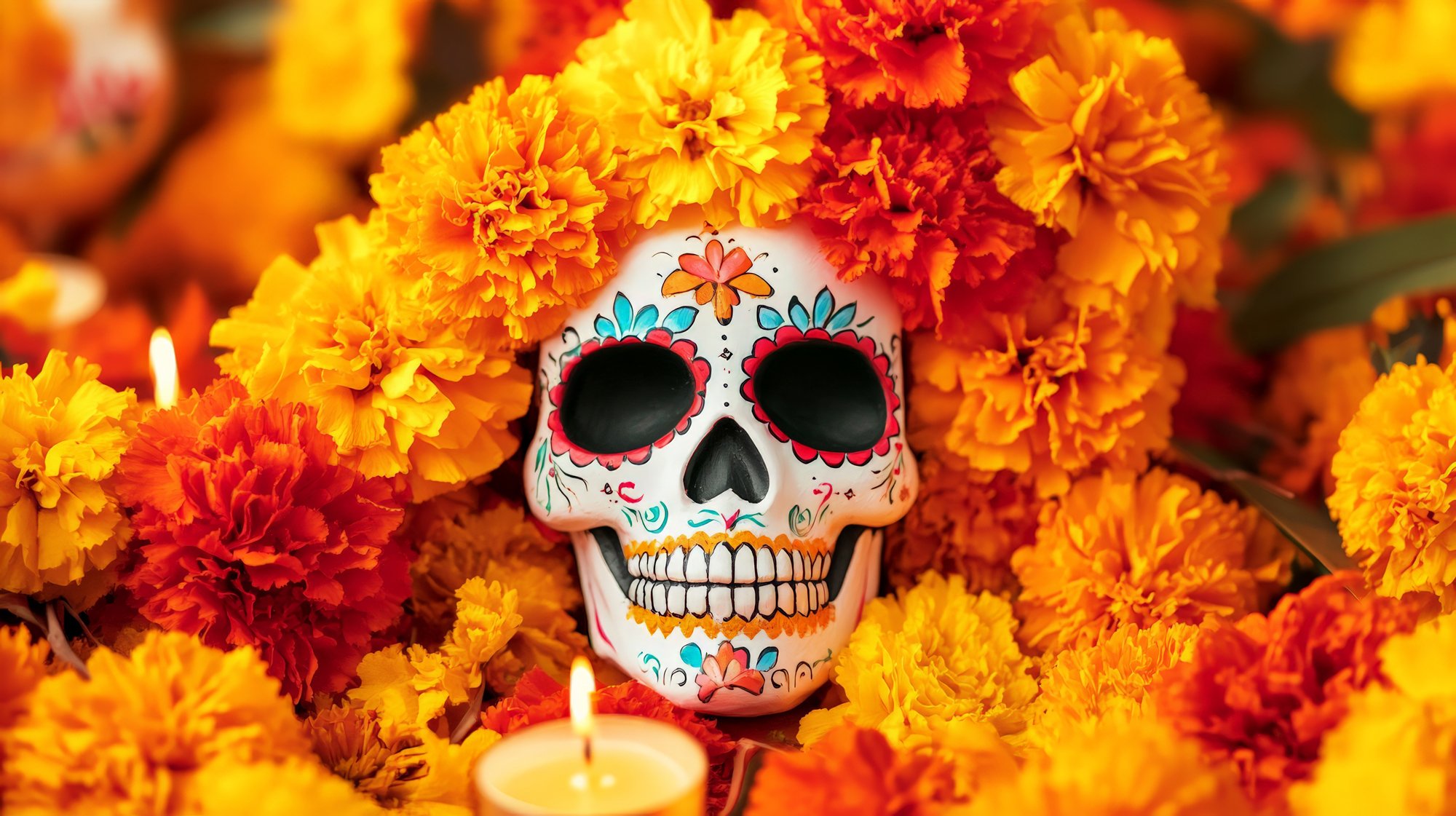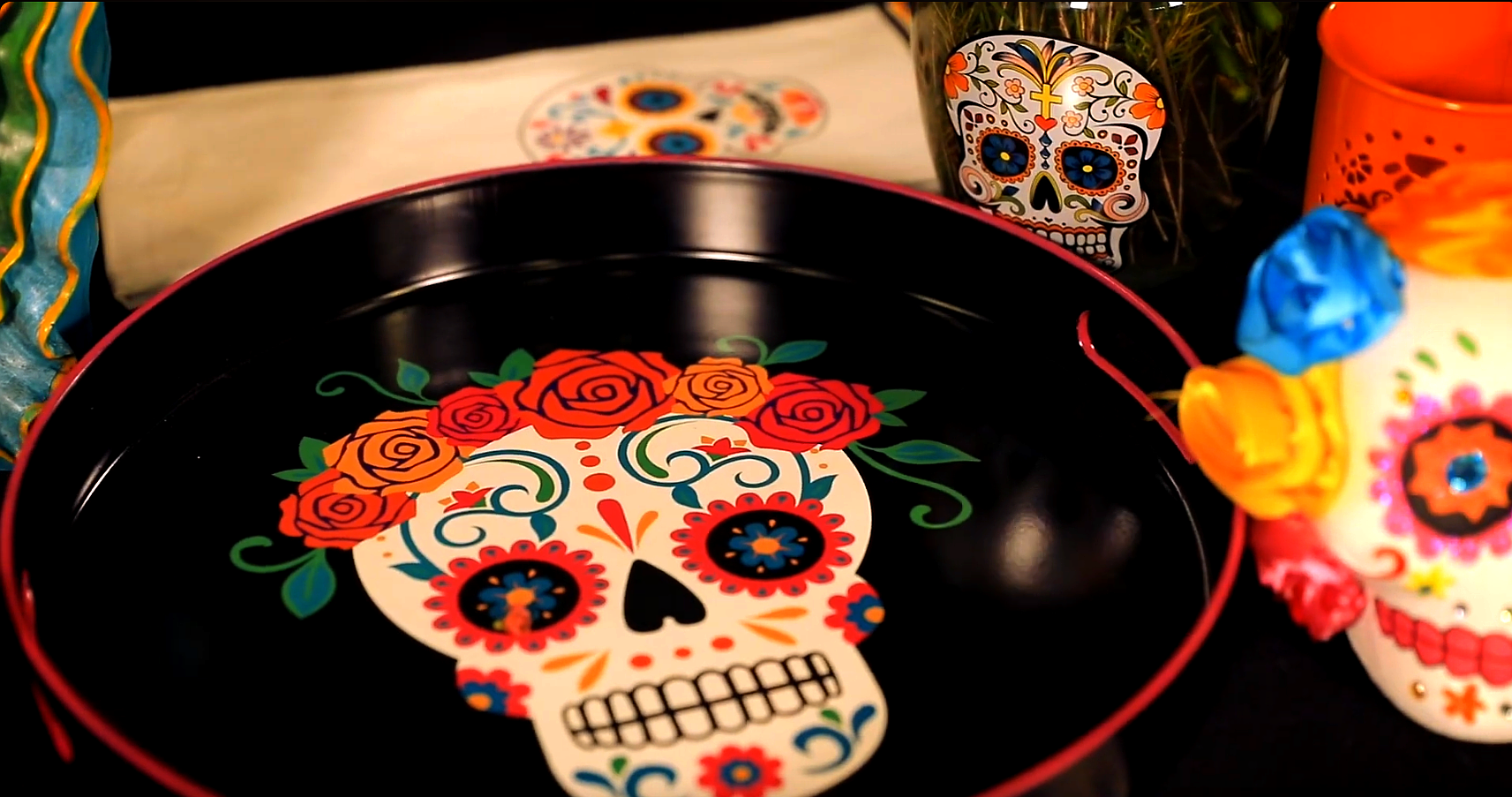Day of the Dead Decoration Ideas
Day of the Dead, or Día de los Muertos, is a beautiful and meaningful Mexican tradition. It is a multi-day holiday held from November 1-2 and is a period when family and friends gather to celebrate their loved ones who have passed.
Día de los Muertos, or Day of the Dead, is more than just a holiday—it’s a soulful and joyful tribute to loved ones who have passed on. Celebrated from November 1st to 2nd, this cherished Mexican tradition brings families and communities together to honor ancestors with colorful decor, fragrant flowers, glowing candles, and offerings that reflect a loved one’s life and legacy.
Whether you grew up celebrating or are embracing it for the first time, creating Day of the Dead decorations is a powerful way to celebrate the cycle of life with beauty, remembrance, and artful intention.
I wanted to do something to celebrate this beautiful tradition, so in this DIY tutorial video I created a fun way to decorate your home for the Day of the Dead. I used traditional Day of the Dead decorations such as candles, marigold florals, decorative figurines and other beautiful elements the bring the holiday to life.
What Are Traditional Day of the Dead Decorations?
Traditional Day of the Dead decor is full of symbolism. Each element carries meaning and is selected with care to welcome the spirits of those who have passed. Common decorations include:
Candles that light the way for returning souls
Marigold flowers (known as cempasúchil) for their bright color and strong scent, which are believed to guide spirits home
Sugar skulls and skeleton figurines to celebrate the dead joyfully, not mournfully
Food offerings, favorite treats, or pan de muerto to nourish visiting souls
Photos, incense, and papel picado to bring color, scent, and spiritual depth to the altar or tablescape
These elements combine to create an altar—known as an ofrenda—or festive table that is visually stunning and spiritually significant.
Day of the Dead Decor Guide: The Meaning Behind Every Element of Día de los Muertos
Each element of Day of the Dead decorations is layered with history, symbolism, and meaning. Whether you’re setting up an elaborate altar (ofrenda) or styling a festive table for friends and family, understanding why each piece matters helps you create a space that’s not just beautiful, but spiritually rich.
Let’s explore the core Day of the Dead decor elements—and how to use them to honor, celebrate, and connect with those who’ve passed.
Marigolds (Cempasúchil): The Flower of the Dead
If there’s one flower that defines Día de los Muertos, it’s the marigold—known in Spanish as cempasúchil. Its rich orange and golden tones symbolize the sun, life, and rebirth, guiding spirits back to the world of the living with both color and scent.
In traditional Day of the Dead decorations, marigolds are used to line pathways, decorate altars, and form crowns or garlands. Whether you opt for fresh blooms or silk florals, marigolds are essential for creating an atmosphere that’s both spiritual and vibrant.
Design Tip: Cluster marigolds around candles or trays of offerings, or create a floral collar around a bucket of roses as shown in our DIY decor video for a modern take.
Candles: Lighting the Path for Returning Souls
Candles are more than ambiance—they are spiritual beacons. In Día de los Muertos, candles represent the element of fire and serve to light the way for souls as they return to visit their loved ones.
You can use a variety of candle styles:
Tall glass prayer candles with sugar skull designs
Votive holders tucked into florals
Skull-shaped candles for added color and texture
Position them on the ofrenda, around photos, or in small groupings
Sugar Skulls & Figurines: Celebrating the Joy of Life
One of the most recognizable icons of Day of the Dead decor is the sugar skull (or calavera). Far from spooky, these decorative skulls are often smiling, colorful, and adorned with flowers, glitter, or gemstones. They celebrate the sweetness and vibrancy of life, reminding us that death is not the end—but a continuation.
Decorative skulls appear in painted ceramic figurines, resin sculptures of skeleton musicians and dancers, candles shaped like skulls, and plates, cups or coasters printed with calavera designs. These joyful symbols are meant to reflect the personality of your loved ones with charm, flair, and playfulness.
DAY OF THE DEAD DECORATIONS - SKULL SHAPED SALT AND PEPPER SHAKERS FROM EZLD
DAY OF THE DEAD DECORATIONS - SKULL SHAPED MUGS FROM EZLD
Style Idea: Arrange small sugar skulls in front of framed photos on your altar or scatter them across your table among florals and napkins for a whimsical, festive look.
Photographs & Personal Mementos: Honoring Loved Ones
Every ofrenda begins with photos of the departed. These are the heart of your altar—bringing the faces, names, and legacies of loved ones back into the present. Next to the photos, place small personal items: a favorite teacup, a handwritten note, or something that belonged to them.
These intimate touches make your Day of the Dead decorations deeply personal and emotionally grounding.Remember, you don’t always need a full altar. A side table, shelf, or even a decorative tray with a photo, candle, and flower can serve as a mini-ofrenda filled with love.
Pan de Muerto & Treats: Nourishing the Spirits
Food offerings are a joyful part of Día de los Muertos decor. The most iconic is pan de muerto—a slightly sweet bread decorated with bone-shaped pieces of dough. Other treats might include chocolate, sugar skull candies, fruit, and favorite snacks or drinks of your loved one
In our featured decor video, we used colorful trays to hold sweets—making the treats a visual element as well as a symbolic one. Use a decorative tray surrounded by flowers and candles to display your offerings in a way that’s both meaningful and beautiful.
Papel Picado: The Spirit in the Wind
Papel picado, or “pierced paper,” is a traditional Mexican folk art made by cutting designs into colorful tissue paper. These intricate banners symbolize the fragility of life and the element of air.
Hang papel picado above your ofrenda, across a mantle, in a doorway, or over your table as a backdrop. Choose colors that match the rest of your decor—purple for mourning, yellow for light, or pink for joy. You can make your own papel picado or buy pre-cut banners to layer in different colors for added texture.
What Is an Ofrenda? The Heart of Día de los Muertos
At the center of every Día de los Muertos celebration is the ofrenda—an altar created to honor and welcome back the souls of departed loved ones. The word ofrenda means “offering” in Spanish, and that’s exactly what this sacred space is: a visual and spiritual offering made with love, intention, and memory.
Framed photos, candles, and fragrant marigold flowers (cempasúchil) are arranged alongside their favorite foods, drinks, and personal mementos. Many families include pan de muerto, sugar skulls, and small items that reflect a loved one’s personality—like a handwritten note, a favorite book, or a piece of jewelry.
Other traditional items include papel picado (colorful cut paper banners that represent the fragility of life), copal incense to purify the space, and decorative figurines like painted skulls or skeletons that bring levity and celebration to the remembrance. Even the colors used—orange, yellow, hot pink, purple, and turquoise—carry symbolic weight, chosen to evoke both spiritual meaning and festive energy.
What Are the Traditional Colors of Day of the Dead—and What Do They Mean?
Color plays a powerful role in Día de los Muertos celebrations. Far from being random or purely decorative, each hue is intentionally chosen to honor the dead, celebrate life, and convey spiritual meaning. Traditional Day of the Dead colors include orange and yellow, pink, red, purple, white, black, and in modern decor, turquoise and blue tones. These colors fill ofrendas, homes, cemeteries, and public altars throughout Mexico and beyond, with each color holding its own meaning.
If you're wondering "What are the traditional colors of Day of the Dead and what do they symbolize?", here's a closer look:
Orange & Yellow
Marigold flowers (cempasúchil) are the most iconic symbols of Día de los Muertos, and their vivid orange and yellow petals dominate the holiday’s visual palette. These colors represent the sun and light—guiding souls back to the world of the living. Orange also symbolizes the cycle of life and death, while yellow evokes hope, warmth, and remembrance. Scatter marigolds across your altar or tablescape, or use silk versions for a long-lasting effect.
Pink & Red
Hot pink and deep red inject vibrancy and energy into Day of the Dead decor. These colors are tied to joy, celebration, and the beauty of life, especially the lives being remembered. Unlike somber mourning traditions in other cultures, Día de los Muertos is filled with laughter and light—and pink and red reflect that festive spirit. Incorporate these hues through tinted roses, woven napkins, or decorative votive holders.
Purple
In Mexican culture, purple symbolizes mourning, grief, and the spiritual journey. It's often used to strike a balance between reverence and celebration. On an ofrenda, purple candles or accents can reflect introspection and the sacredness of the space. Add this shade through candles, textiles, or even papel picado to deepen the altar’s meaning.
White
White represents purity, innocence, and hope, especially when honoring the souls of children, known as angelitos. White candles, flowers, or ceramics offer a soft contrast to the brighter colors and add serenity to your display. Many people use lace, white roses, or white skull figurines to infuse this peaceful tone into their decor.
Black
Black is often used to represent death itself, but in Día de los Muertos, it’s not portrayed as scary or grim. Instead, it reflects the mystery of the afterlife, the unknown, and the spiritual power of transformation. When paired with color, black adds dramatic contrast and can frame your setup with visual weight. Use black candlesticks, ceramic containers, or ribbon trim to ground your design.
Turquoise & Blue Tones
Turquoise and blue are not always listed among the traditional colors, but they’ve become popular in modern interpretations of Day of the Dead decor. Blue symbolizes tranquility, faith, and trust, while turquoise often appears in folk art and regional textiles, making it a beautiful and culturally rich addition to your palette. Try using turquoise glass vases or dyed silk florals for a fresh twist on the classic color scheme.
How to Use These Colors in Your Day of the Dead Decor
To make your Día de los Muertos decorations visually striking and spiritually resonant:
Group colors intentionally. Try creating clusters of orange and pink flowers, or layering purple and white textiles beneath trays of sweets and candles.
Create contrast. Balance dark elements like black candle holders with bright marigolds or neon pink votives.
Mix fresh and silk elements. Use tinted roses, hot pink wax flowers, and artificial botanicals to maintain the vibrancy throughout the two-day celebration.
Anchor with color. Use colorful napkins as placemats, or wrap votive candles with ribbons in red, purple, or turquoise for festive flair.
How Do You Decorate for Día de los Muertos at Home?
In our DIY Day of the Dead decoration video above, we demonstrate a simple yet beautiful way to honor this tradition through a colorful, floral-centric table display. You don’t need to create a full altar to participate—your kitchen table, entryway console, or even a coffee table can become a space for reflection and joy.
Start with a low floral container, pre-lined with soaked floral foam to help fresh blooms last longer. For cost efficiency, keeping the foam low means you can use fewer flowers while still achieving a full look. Use wax flowers and tinted roses, trimming stems at a 45-degree angle for better hydration. Surround your arrangement with skull-shaped votive candles, resin skeleton figurines, or even glass vessels adorned with Day of the Dead motifs.
To elevate the look, we used silk botanicals in electric hues—perfect for creating lasting arrangements and vibrant accents.
Shop for Day of the Dead Accessories in my online shop at EZLD.co!
Want more creative decor ideas?
Join our mailing list for articles, update, and special events, and download Eddie’s FREE GUIDE to his Top Tools and Materials for Florists and DIYers.











